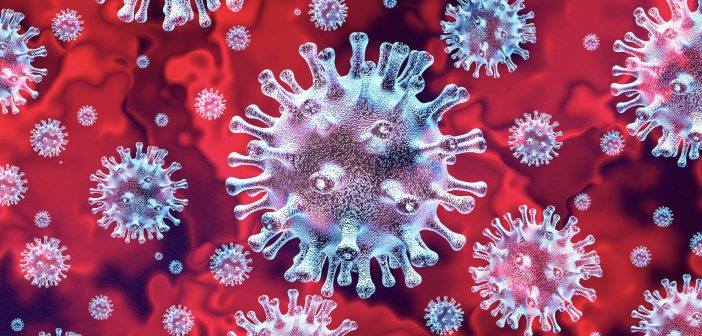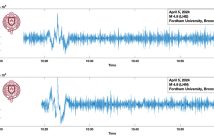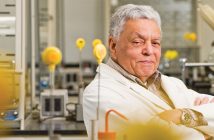Two Fordham biologists are conducting research at Rose Hill that could be instrumental in treating COVID-19.
Building on research started before the pandemic, the scientists are testing whether or not they can prevent protein receptors on the surface of lung cells from hosting COVID-19.
“There are thousands of scientists working all over the world who are trying to change the course of this virus,” said Berish Y. Rubin, Ph.D., a professor in biological sciences and the head of the Laboratory for Familial Dysautonomia Research, who has been working on this project with Sylvia L. Anderson, Ph.D., director of their laboratory, since March. “We think we bring a unique point of view and perspective.”
Before the pandemic began, the two scientists studied a genetic disorder known as familial dysautonomia. For years, they explored different ways to manipulate gene expression. As COVID-19 spread across the world, they realized their prior research could lead to a new therapy or preventative approach for the virus.
The new coronavirus infiltrates the body by attaching to the “ACE2” protein on the surface of our lung cells, said Rubin. But in order for the virus to bind, the protein needs to be a specific shape. Imagine them as a key and a lock, said Rubin.
“Only certain keys will work in certain locks. Think of the lock as being the ACE2 protein and the key as the virus that needs to fit into the hole in the lock in order to be able to infect the cell,” Rubin explained.
In the meantime, scientists around the world have been working on a cure. Researchers from Gilead Sciences Inc. have developed Remdesivir, an experimental antiviral drug that has recently gained popularity. Scientists have also identified tiny molecules that can block the site the virus needs to connect to, said Rubin. But they haven’t tried to change the original shape of the ACE2 protein, he said.
“What we’ve been working on is changing the configuration of the ACE2 receptor, [the same way]we have changed the configurations of lots of proteins we’ve worked on in the past, so that the site the virus needs to attach to is no longer accessible. If it’s no longer accessible, the virus can’t infect the cell,” Rubin explained. “If I change the hole on the lock so the key no longer fits, then I cannot be infected.”
This could lead to the development of a new therapy or prophylactic for COVID-19, he said.
Before coming to Fordham, Rubin conducted research in immunology and virology at Memorial Sloan Kettering and the New York Blood Center. His studies, including AIDS treatment research, has been published in many journals, including the New England Journal of Medicine. In the fall of 1989, he arrived at Fordham, where he and Anderson first identified the cause of familial dysautonomia, a rare genetic disorder that affects the development and functioning of a person’s autonomic nervous system. In 2017, the two scientists received the Janet Davison Rowley Patient Impact Research Award for their work on the disorder.
This past March, they started experimenting with cell extracts from their prior research with a possible treatment for COVID-19 in mind. Now, they are growing hundreds of lung cell cultures and testing them with 2,000 different compounds that could reshape the ACE2 protein. The majority of the compounds are common drugs like aspirin and Zantac, which have already been approved by the Food and Drug Administration. The other compounds are “nutraceuticals”—fortified food products or nutritional supplements that you could find in a health food store, said Rubin. These can have promising results, as in the case of Rice Dream, an organic milk alternative that they identified to have an ingredient that aids patients with familial dysautonomia.
“We are evaluating whether anything in our panel will change the structure of the ACE2 protein to limit or block the ability of the virus to enter and infect the lung cells,” said Rubin.
Rubin and Anderson are among the scant few who remain at the Rose Hill campus. After the campus closed, they received an exemption from the Office of the Governor for their research. They don’t work side by side—they operate in separate areas, more than six feet apart. Their graduate students who normally work beside them are now stuck at home, as far away as Nebraska, said Rubin.
The pandemic has affected their lives in other ways. Rubin said he knows at least a dozen people who have passed away from the virus, including a high school classmate. Another friend survived after being on a ventilator for 15 days, but still experiences shortness of breath. And he hasn’t had physical contact with his mother, age 93, for weeks, he said. Anderson, who is in the lab seven days a week, socializes on Zoom and FaceTime when she can find the time.
By the end of summer, the two scientists will hope to submit their first publication on their COVID-19 research. By then, they will know whether or not they have viable results that could result in a potential treatment, said Rubin.
Speaking by telephone from the Larkin Hall lab, Rubin said he is hopeful that the work will lead to a breakthrough quickly.
“Every day makes a difference for people’s health and well-being all over the world,” he said.



